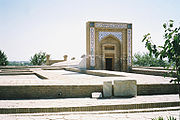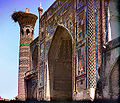
Ulugh Beg Observatory
Encyclopedia


Samarkand
Although a Persian-speaking region, it was not united politically with Iran most of the times between the disintegration of the Seleucid Empire and the Arab conquest . In the 6th century it was within the domain of the Turkic kingdom of the Göktürks.At the start of the 8th century Samarkand came...
, Uzbekistan
Uzbekistan
Uzbekistan , officially the Republic of Uzbekistan is a doubly landlocked country in Central Asia and one of the six independent Turkic states. It shares borders with Kazakhstan to the west and to the north, Kyrgyzstan and Tajikistan to the east, and Afghanistan and Turkmenistan to the south....
. Built in the 1420s by the Timurid
Timurid Dynasty
The Timurids , self-designated Gurkānī , were a Persianate, Central Asian Sunni Muslim dynasty of Turko-Mongol descent whose empire included the whole of Iran, modern Afghanistan, and modern Uzbekistan, as well as large parts of contemporary Pakistan, North India, Mesopotamia, Anatolia and the...
astronomer Ulugh Beg
Ulugh Beg
Ulugh Bek was a Timurid ruler as well as an astronomer, mathematician and sultan. His commonly-known name is not truly a personal name, but rather a moniker, which can be loosely translated as "Great Ruler" or "Patriarch Ruler" and was the Turkic equivalent of Timur's Perso-Arabic title Amīr-e...
, it is considered by scholars to have been one of the finest observatories in the Islamic world at the time and the largest in Central Asia before it was destroyed in 1449. Some of the famous Islamic astronomers who worked at the observatory include Al-Kashi, Ali Qushji, and Ulugh Beg himself.
History and astronomical equipment
In 1420, the great astronomer Ulugh Beg built a madrasahMadrasah
Madrasah is the Arabic word for any type of educational institution, whether secular or religious...
in Samarkand, named the Ulugh Beg Madrasah. It became an important centre for astronomical study and only invited scholars to study at the university whom he personally approved of and respected academically and at its peak had between 60 and 70 astronomers working there. In 1424, he began building the observatory to support the astronomical study at the madrasah and it was completed five years later in 1429. Beg assigned his assistant and scholar Ali Qushji to take charge of the Ulugh Beg Observatory which was called Samarkand Observatory at that time. He worked there till Ulugh Beg was assassinated.
Other notable astronomers made observations of celestial movements at the observatory, including Qāḍīzāda al-Rūmī (who took charge of the madrasah and observatory after Ali Qushji's death) and Jamshid Kashani.

While working at the excavation site, Vyatkin found one of the most important astronomical instruments used at the observatory: a large arch that had been used to determine midday. A trench of about 2 metres wide was dug in a hill along the line of the Meridian and in it was placed the arc of the instrument. Today, there is a circular base showing the outline of the original structure and the doorway leads to the remaining underground section of the Fakhrī sextant
Sextant
A sextant is an instrument used to measure the angle between any two visible objects. Its primary use is to determine the angle between a celestial object and the horizon which is known as the altitude. Making this measurement is known as sighting the object, shooting the object, or taking a sight...
that is now roofed over. The sextant was 11 metres long and once rose to the top of the surrounding 3 storey structure although it was kept underground to protect it from earthquakes. Calibrated along its length, it was the world's largest 90 degree quadrant at the time, with a radius of 40.4 metres. The radius of the meridian arc
Meridian arc
In geodesy, a meridian arc measurement is a highly accurate determination of the distance between two points with the same longitude. Two or more such determinations at different locations then specify the shape of the reference ellipsoid which best approximates the shape of the geoid. This...
was according to a trusted middle age
Middle Ages
The Middle Ages is a periodization of European history from the 5th century to the 15th century. The Middle Ages follows the fall of the Western Roman Empire in 476 and precedes the Early Modern Era. It is the middle period of a three-period division of Western history: Classic, Medieval and Modern...
Turkish astronomer approximately 50 metres and was said to be the same height as the dome of the Hagia Sofia mosque in Istanbul
Istanbul
Istanbul , historically known as Byzantium and Constantinople , is the largest city of Turkey. Istanbul metropolitan province had 13.26 million people living in it as of December, 2010, which is 18% of Turkey's population and the 3rd largest metropolitan area in Europe after London and...
. It was used for the observation of the Sun, Moon and other celestial bodies, and along with other sophisticated equipment such as an armillary
Armillary sphere
An armillary sphere is a model of objects in the sky , consisting of a spherical framework of rings, centred on Earth, that represent lines of celestial longitude and latitude and other astronomically important features such as the ecliptic...
and an astrolobe, the astronomers working in Samarkand could determine noon every day according to the meridional height of the Sun, distance from the zenith
Zenith
The zenith is an imaginary point directly "above" a particular location, on the imaginary celestial sphere. "Above" means in the vertical direction opposite to the apparent gravitational force at that location. The opposite direction, i.e...
and declination.
By 1737, scholarly studies using the observatory had updated the Ilkhanic Tables
Zij-i Ilkhani
Zīj-i Īlkhānī or Ilkhanic Tables is a Zij book with astronomical tables of planetary movements. It was compiled by the Persian astronomer Nasir al-Din al-Tusi in collaboration with his research team of astronomers at the Maragha observatory...
which had previously been observed in the 1260s and 1270s at the Maragheh observatory
Maragheh observatory
Maragheh observatory is an astronomical observatory which was established in 1259 CE by Nasir al-Din al-Tusi, an Iranian scientist and astronomer...
, which provided valuable sine and tangent tables, and the Zij-i Sultani, which displayed improved planetary parameters and the plotting of the coordinates of 1,018 star positions based on some original research at the observatory rather than purely being an update of the work of Ptolemy
Ptolemy
Claudius Ptolemy , was a Roman citizen of Egypt who wrote in Greek. He was a mathematician, astronomer, geographer, astrologer, and poet of a single epigram in the Greek Anthology. He lived in Egypt under Roman rule, and is believed to have been born in the town of Ptolemais Hermiou in the...
or al-Sufi. In fact, Ulugh Beg and his scholars had computed many inaccuracies in their work as he explained in his preface under the heading "Determination of the Places of the Fixed Stars in Longitude and Latitude":
These discoveries and research conducted at Ulugh Beg Observatory were very important at the time as astronomers could predict eclipses and calculate the hour of the rising sun and altitude of a celestial body, and meant their hypothesis of a stellar year was rather accurate, at 365 days, 6 hours, 10 minutes and 8 seconds, only about 1 minute longer than the modern electronic calculations. Although the observatory was destroyed in 1449, scholarly astronomical study continued in Samarkand for some 75 years.
Zij-i Sultani
Zīj-i Sultānī is a ZijZij
Zīj is the generic name applied to Islamic astronomical books that tabulate parameters used for astronomical calculations of the positions of the Sun, Moon, stars, and planets. The name is derived from the Middle Persian term zih or zīg, meaning cord...
astronomical table and star catalogue that was published by Ulugh Beg
Ulugh Beg
Ulugh Bek was a Timurid ruler as well as an astronomer, mathematician and sultan. His commonly-known name is not truly a personal name, but rather a moniker, which can be loosely translated as "Great Ruler" or "Patriarch Ruler" and was the Turkic equivalent of Timur's Perso-Arabic title Amīr-e...
in 1437. It was the joint product of the work of a group of Muslim astronomers working under the patronage of Ulugh Beg at the Samarkand
Samarkand
Although a Persian-speaking region, it was not united politically with Iran most of the times between the disintegration of the Seleucid Empire and the Arab conquest . In the 6th century it was within the domain of the Turkic kingdom of the Göktürks.At the start of the 8th century Samarkand came...
observatory
Observatory
An observatory is a location used for observing terrestrial or celestial events. Astronomy, climatology/meteorology, geology, oceanography and volcanology are examples of disciplines for which observatories have been constructed...
. These astronomers included Jamshīd al-Kāshī
Jamshid al-Kashi
Ghiyāth al-Dīn Jamshīd Masʾūd al-Kāshī was a Persian astronomer and mathematician.-Biography:...
and Ali Qushji, among others.
Beg determined the length of the sidereal year
Sidereal year
A sidereal year is the time taken by the Earth to orbit the Sun once with respect to the fixed stars. Hence it is also the time taken for the Sun to return to the same position with respect to the fixed stars after apparently travelling once around the ecliptic. It was equal to at noon 1 January...
as 365d 5h 49m 15s, which has an error of +25s, making it more accurate than Nicolaus Copernicus
Nicolaus Copernicus
Nicolaus Copernicus was a Renaissance astronomer and the first person to formulate a comprehensive heliocentric cosmology which displaced the Earth from the center of the universe....
' estimate which had an error of +30s. Beg also determined the Earth's axial tilt
Axial tilt
In astronomy, axial tilt is the angle between an object's rotational axis, and a line perpendicular to its orbital plane...
as 23.52 degrees, which remains the most accurate measurement to date. It was more accurate than later measurements by Copernicus and Tycho Brahe
Tycho Brahe
Tycho Brahe , born Tyge Ottesen Brahe, was a Danish nobleman known for his accurate and comprehensive astronomical and planetary observations...
, and it matches the currently accepted value precisely.
Museum
The Ulug Beg Observatory Museum was built in 1970 to commemorate Ulug Begh. Ulug Beg's Star Charts, the Zij-i Sultani are kept in the museum although they are copies; the original drawings are in OxfordOxford
The city of Oxford is the county town of Oxfordshire, England. The city, made prominent by its medieval university, has a population of just under 165,000, with 153,900 living within the district boundary. It lies about 50 miles north-west of London. The rivers Cherwell and Thames run through...
, England.

